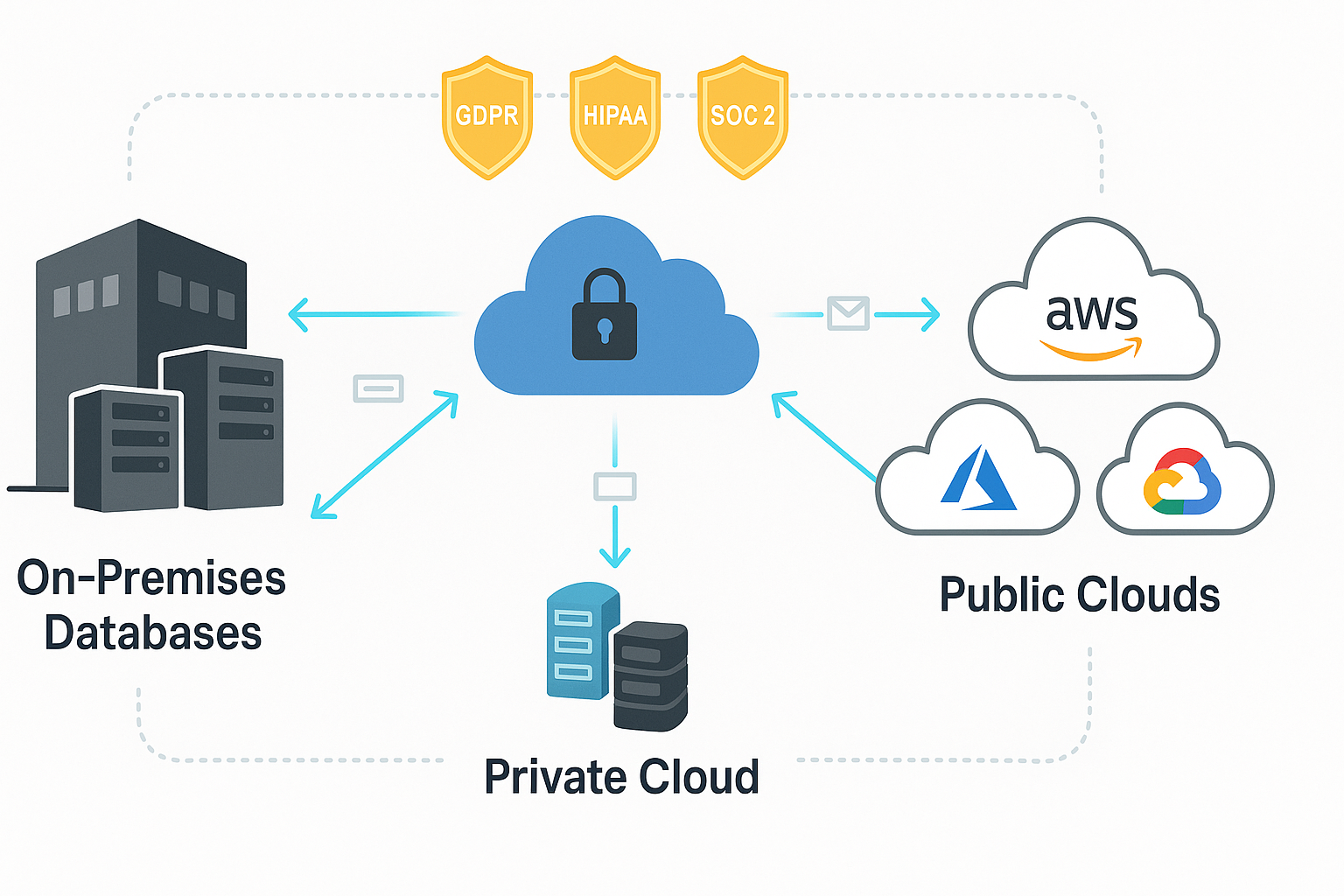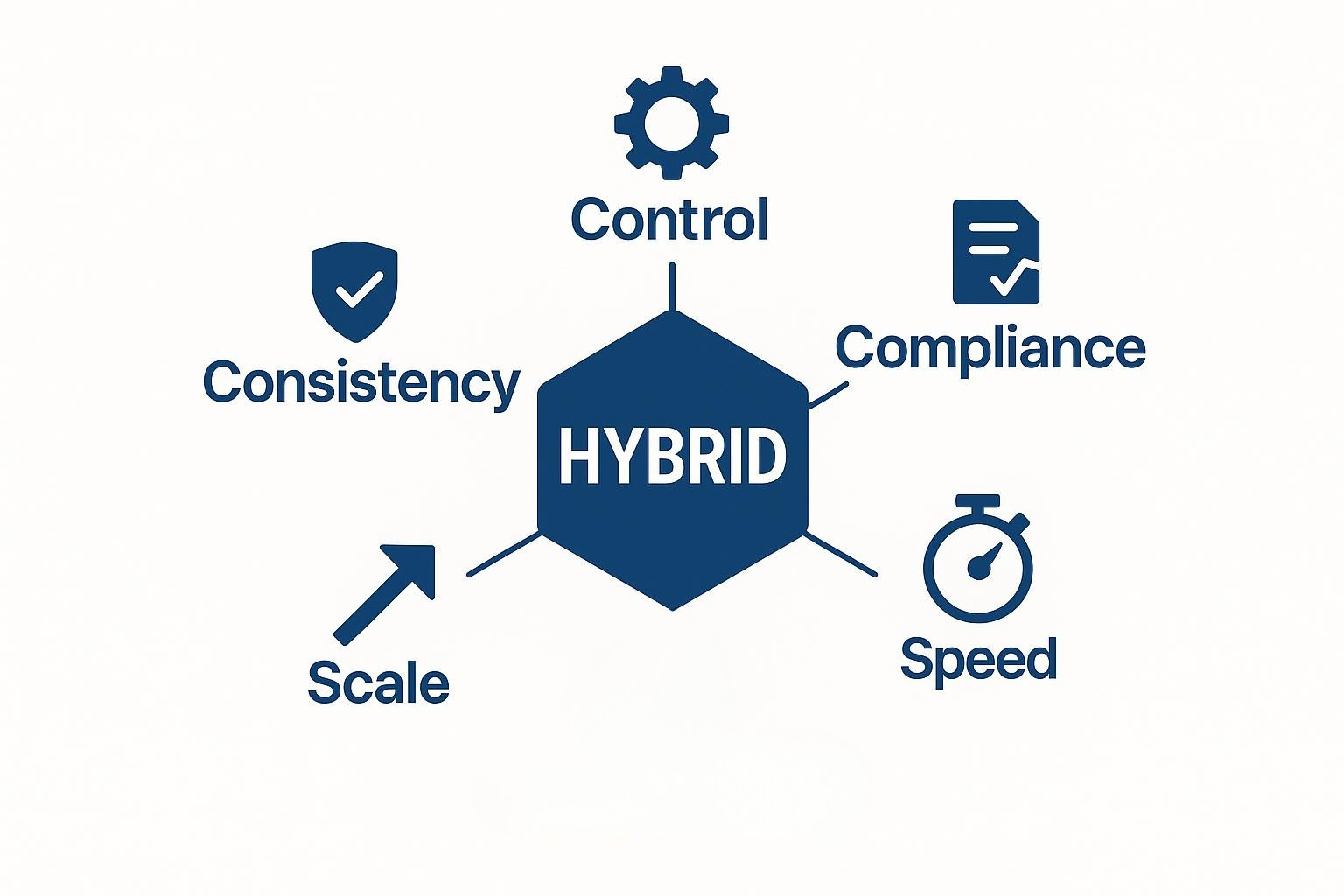Data Integration For Hybrid Cloud
Summarize this article with:
✨ AI Generated Summary
Hybrid cloud data integration addresses the challenges of real-time, compliant data synchronization across on-premises, private, and public clouds by separating control and data planes to maintain low latency, data sovereignty, and unified governance. Traditional batch ETL, SaaS platforms, and custom scripts fail to meet modern demands due to latency, compliance risks, and scalability issues.
- Key requirements: location-aware control, compliance-first architecture, unified codebase, low latency, and scalable workloads.
- Airbyte Enterprise Flex offers a hybrid model with cloud-based control and on-premises data planes, supporting 600+ connectors and ensuring regulatory compliance without vendor lock-in.
- Outcomes include faster integration (weeks vs. months), cost reduction (60-80%), and future-proof pipelines adaptable across environments and regulations.
A few seconds can decide millions. Midway through a trading session, CDC replication in your fraud-detection pipeline drifts past 30 seconds. Authorizations queue up, alerts cascade, and each extra millisecond increases exposure to fraudulent transactions.
This scenario captures the broader challenge of hybrid cloud data integration. Whether you are securing payments, managing patient records, or tracking IoT devices, real-time synchronization must happen without breaking latency, privacy, or residency rules.
Yet most teams still rely on batch ETL, SaaS tools that process data outside their control, or fragile in-house scripts. The result is the same replication lag that causes downtime, compliance gaps, and delayed insights.
This guide explores how modern hybrid integration architectures close that gap and keep critical systems running at full speed.
What Is Data Integration for Hybrid Cloud?
Hybrid cloud represents the reality where your on-premises databases, private clouds, and multiple public cloud services all need to communicate seamlessly, often while meeting strict regulatory requirements.

Data integration in this setting means moving, transforming, and governing information across every one of those environments without breaking security or performance guarantees. The challenge is distance and diversity. You have to bridge legacy systems that never exposed APIs while normalizing streams of structured, semi-structured, and unstructured information from different clouds, each with its own format and rate of change.
Traditional batch-oriented ETL centralizes everything in a single warehouse, which violates residency rules and introduces hours of latency. SaaS-only integration platforms process information outside your control, creating location risk for regulated industries. Hybrid cloud integration demands location-aware pipelines that keep sensitive workloads close to source, synchronize them in near real time, and offer unified monitoring.
Fail to meet those requirements and you inherit information silos that hide insight, compliance gaps that trigger audits, and performance bottlenecks that stall real-time use cases. Effective hybrid integration eliminates those risks and lets you use the flexibility the cloud promised.
What's Broken in Current Hybrid Cloud Integration Approaches?
Teams rely on legacy ETL jobs, SaaS integration platforms, or home-grown scripts to move information between on-prem systems and multiple clouds. These approaches break down when compliance boundaries, latency targets, and multi-region sovereignty requirements enter the picture.
Legacy ETL Platforms Can’t Keep Up with Real-Time Needs
Batch-oriented ETL tools were built for nightly warehouse loads, not second-by-second analytics. Moving information in large batches means your fraud models or IoT dashboards trail reality by hours, which is a gap modern businesses can't tolerate.
Licensing fees are just the start. Teams often dedicate 30-50 engineers to keep pipelines running, with headcount growing every time they add a new source. Most ETL suites centralize processing in a single warehouse. When that warehouse sits outside the required jurisdiction, you immediately violate residency rules.
SaaS Integration Tools Break Data Sovereignty
Low-code iPaaS products move information in real time, but processing happens inside the vendor's cloud. The platform, and not you, decides where processing occurs. That's a deal-breaker when GDPR, HIPAA, or local telecom rules demand in-region handling.
Once messages cross borders, audits get messy and remediation slows. Performance suffers too, as every record takes an extra network hop through the provider's multi-tenant environment, adding latency you feel during peak trading hours or when millions of CDRs hit billing systems.
Custom Integrations Don’t Scale or Stay Secure
Building your own connectors feels like ultimate control but rarely scales. Engineering time evaporates fixing brittle API calls each time a vendor changes a field.
During traffic spikes, handcrafted scripts buckle because they lack built-in retry logic, load balancing, or parallelization. Every hour spent on plumbing is an hour not spent on features your customers notice. Home-grown glue code quietly expands attack surface and technical debt.
Compliance and Latency Gaps Hit Regulated Sectors Hard
The cracks widen inside regulated or real-time industries:
- Financial services cannot afford CDC lag during trading surges
- Healthcare must prove every PHI touchpoint for HIPAA audits
- Manufacturers need sensor information in near real time to prevent line stoppages
- Telecom operators juggle billions of regional CDRs under strict sovereignty mandates
When integration tooling ignores these sector-specific constraints, you risk outages, fines, and lost competitiveness.
What Do Teams Need from Hybrid Cloud Integration?

In regulated, performance-sensitive environments, five requirements determine whether your hybrid integration succeeds or fails:
- Control over where data sits and processes
- Compliance built into the architecture from day one
- Consistency across all deployment environments
- Speed that supports real-time decision-making
- Scale that adjusts automatically to workload demands
Sovereignty and Control
You decide where information sits and where it processes, not your vendor. Location-aware controls route traffic based on jurisdictional rules, keeping EU customer records in-region while US log information moves freely. Policy engines enforce boundaries without manual intervention.
Compliance-First Architecture
Retrofitting security creates endless problems. Your hybrid integration stack should ship with end-to-end encryption, granular IAM, and audit logs that satisfy auditors across multiple geographies. Continuous monitoring and automated alerts turn compliance from a quarterly scramble into a background process.
Unified Codebase
Running different feature sets in cloud and on-premises versions creates gaps when you migrate workloads. A single codebase prevents feature drift and lets you move pipelines gradually.
Patches, connector updates, and new capabilities are delivered consistently across environments, reducing split deployment problems that plague mixed environments.
Low Latency Performance
Batch windows measured in hours break real-time fraud checks and IoT dashboards. Processing planes close to the source reduce network hops and keep CDC lag under control. Smart caching and streaming pipelines collapse wait times without sacrificing resiliency.
Flexibility and Scalability
Workloads spike unpredictably. Your integration layer should scale out automatically when end-of-quarter reporting or holiday traffic hits, then scale back to control costs.
API-first design makes it easy to connect new sources, while dynamic resource allocation aligns spend with actual usage rather than static forecasts.
How Does Hybrid Cloud Data Integration Work in Practice?
Hybrid integration succeeds when you keep orchestration and governance centralized while letting information stay exactly where regulations and performance demands require. The model that delivers this balance separates a lightweight, cloud-hosted control system from the processing power that moves records on-prem or in your VPC.
Splitting Control and Data Planes for True Hybrid Control
The control plane handles configuration, scheduling, and monitoring, while the data plane executes the actual extraction and loading. By decoupling the two, you get centralized management without forcing sensitive information through a public SaaS service.
In practice, the control plane lives in the cloud, issuing jobs to containerized connectors running wherever your sources and targets reside. Those workers initiate outbound-only connections, so you never open inbound firewall ports, which is a simple but effective way to reduce your attack surface.
The result is centralized policy management with local processing that keeps latency low and respects residency requirements.
Securing Every Layer with Unified Governance
Splitting planes only helps if security travels with every packet. End-to-end encryption, granular role-based access control, and exhaustive audit logs must be enforced across both layers.
Industries under GDPR, HIPAA, or PCI can't afford gray areas, so modern stacks add:
- PII masking and tokenization directly in the data plane
- Immutable logs surfaced to the control plane for auditors
- Unified dashboards that make policy drift obvious
- Automated alerts that flag any violation the moment it happens
Running the Same Architecture Across Any Environment
Because no two compliance regimes look alike, the same architecture needs to run everywhere:
- Fully cloud for maximum convenience
- Hybrid with cloud control and local data planes
- Self-managed on-premises for complete infrastructure control
- Air-gapped for classified workloads
Financial institutions often run tiered hybrids where transaction information processes inside national borders while less-sensitive reference content syncs through a cloud data plane.
Functionality should never differ between these modes. You expect the same connectors, monitoring APIs, and compliance controls whether jobs run beside a mainframe or in a managed Kubernetes cluster. That consistency lets you shift workloads as regulations evolve without rewriting pipelines or retraining teams.
What are Industry Examples of Hybrid Cloud Integration in Action?
Regulated industries face the same challenge: sensitive information stays local, while analytics run in the cloud. These examples show how teams deploy hybrid architectures where control planes manage workflows remotely while data planes handle information on-premises.
Why Airbyte Enterprise Flex Is Built for Hybrid Cloud?

Most integration platforms force a choice: either route everything through their cloud service or build custom solutions from scratch. Airbyte Enterprise Flex eliminates this trade-off by separating the control plane (scheduling, monitoring, and governance) from the data plane where actual extraction and loading occur.
The control plane runs as a managed service, giving you a single UI to orchestrate pipelines across your entire infrastructure. Meanwhile, dockerized connectors run inside your VPC or on-premises environment, so regulated information never crosses boundaries you haven't approved.
Flex delivers:
- 600+ pre-built connectors with identical quality across all deployment models
- CDC replication capabilities for real-time data movement
- API-driven automation for programmatic pipeline management
- Config API server for pipeline definitions
- Temporal service for job coordination
- Workload API that launches containerized connectors close to your sources
Since processing happens inside your perimeter, you can enforce SOC 2 controls, meet GDPR and HIPAA requirements, and capture audit logs without building custom infrastructure.
Because Flex is built on Airbyte's open-source foundation, you avoid vendor lock-in. If your compliance requirements or cost considerations change, you can extend the platform or migrate to self-hosted deployment without losing your investment in connectors and pipeline configurations.
What Outcomes Can Modern Hybrid Cloud Integration Deliver?
The following table summarizes the key outcomes teams achieve when moving from legacy integration to modern hybrid cloud architecture:
How Can You Get Started With Hybrid Cloud Data Integration?
To get started with hybrid cloud data integration, begin by identifying your main pain points such as legacy ETL bottlenecks, SaaS gaps, and data silos that block visibility and slow growth. Most enterprises need this clarity before scaling. Assess your architecture by outlining compliance boundaries, latency requirements, and infrastructure to see which workloads should stay on-premises and which can move to the cloud.
Next, launch a pilot with high-value sources that have measurable business impact. Test CDC replication, validate performance, and confirm latency improvements. Work with compliance teams to ensure sovereignty, encryption, and audit logs meet regulatory standards. Once the pilot succeeds, expand step by step, adding new sources and destinations through a unified control plane that keeps complexity manageable.
Airbyte Enterprise Flex delivers this with cloud control plane and customer-controlled data planes. Talk to Sales about enterprise assessments for compliance-focused deployments or to test technical capabilities with a proof-of-concept.
Frequently Asked Questions
What makes hybrid cloud data integration different from standard cloud integration?
Standard cloud tools assume every workload runs in a single public cloud. Hybrid environments require bridging on-premises databases, private clouds, and multiple public providers—each with distinct APIs and security rules. This complexity creates information silos, latency issues, and governance gaps that traditional ETL or SaaS-only platforms can't address.
How does Airbyte Enterprise Flex handle compliance in regulated industries?
Flex separates the control plane (orchestration) from the data plane (actual execution). You run connectors inside your own VPC or center while Airbyte Cloud manages schedules and monitoring. Sensitive content never leaves your environment, enabling GDPR, HIPAA, or PCI compliance without additional tools.
Can Airbyte support SAP and other large enterprise systems in hybrid deployments?
Airbyte offers 600+ pre-built connectors, including SAP, Oracle, and mainframe sources. All connectors run unchanged whether the data plane sits on-premises or in the cloud, eliminating the feature gaps common with other vendors' hybrid editions.
Is there a risk of vendor lock-in with Airbyte Flex?
Airbyte's open-source foundation gives you complete access to pipelines, connectors, and metadata. You can migrate to self-managed deployment—or another platform—without rewriting code.
What deployment models does Airbyte support for different compliance requirements?
You can run both planes in the cloud, both on-premises, or mix them. Teams often use multiple data planes—EU, US, and APAC—to meet regional residency requirements while maintaining a single control plane for global observability.
How does the hybrid control plane architecture ensure data sovereignty?
The control plane only sends job metadata; all records stay inside your hosted data plane. Outbound-only HTTPS keeps firewalls closed to inbound traffic, so jurisdictions requiring local processing remain compliant while maintaining centralized governance.
What performance improvements can I expect compared to legacy ETL?
Legacy ETL waits for nightly batch windows, leaving you hours behind. Hybrid pipelines using CDC and event-driven connectors push updates continuously, reducing latency from overnight to near-real-time. Teams report moving from multi-hour batch cycles to minute-level freshness after retiring batch-only workflows.

.webp)
.png)